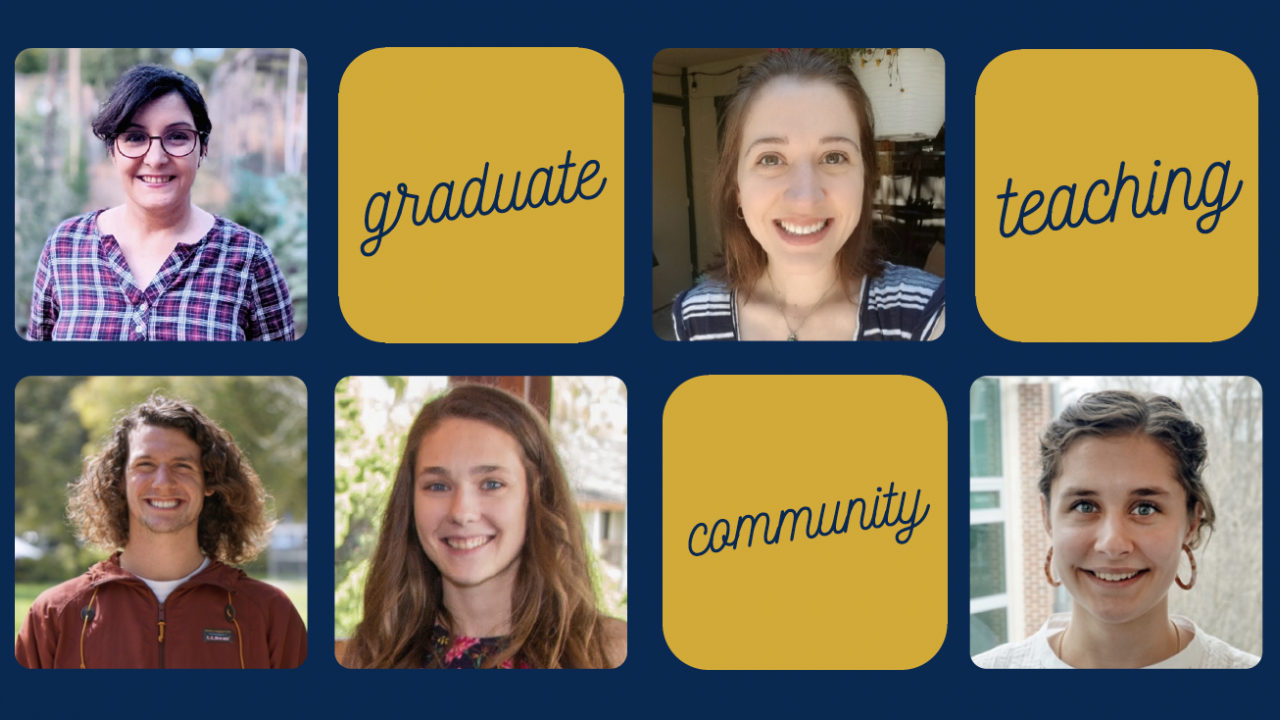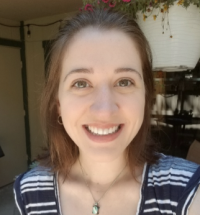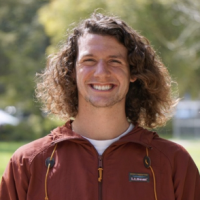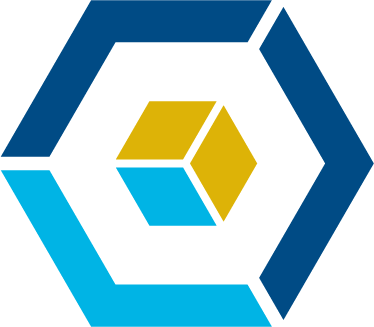
GTC Graduate Teaching Community Reflections
Spring 2021
Introduction
Members of the Graduate Teaching Community reflected on the following prompt at the conclusion of the Spring 2021 quarter: How did participating in the Graduate Teaching Community (GTC) this quarter shape your thinking about teaching?
Nazanin Akrami, PhD Student, Agricultural and Environmental Chemistry

Thinking of greatness, I often envision oak trees with generous canopies, mighty branches, and a sense of wisdom in their character. They grow slowly, savoring every sip of life, but surely. They might even look distant from each other but are bonded through deep, extensive roots. The roots are so vast that they could bring back water and nutrients from about 30 meters away. Through this, the soil beneath the tree richens with nutrients shaping what is known as islands of fertility.
Thinking of branches and roots, bringing in resources, and creating fertile islands resembles the learning process in the following three steps:
- Receiving data (nutrients and water)
- Synthesizing them (biochemical processes, environmental conditions)
- Developing knowledge and creating original outcome (a fertile island)
I believe the primary goal of teaching is learning. The human brain automatically receives data from the environment and synthesizes data through biochemical processes affected by environmental conditions to produce knowledge ultimately. Assuming the plant analogy holds, where does teaching come into play?
In the book Small Teaching, James Lang explains how learning often occurs through connecting subjects. For instance, I learned about electricity with the help of principles I had learned in hydrology. In hydrology, water flows from higher potentials to lower potentials. In electricity, current flows from higher voltages to lower voltages as well. In hydrology, if there is no potential gradient, there would be no flow. There will not be a current in electricity if there is no potential gradient (voltage difference). As water flow consists of many water molecules moving through pipes, electricity current consists of many electrons moving through a wire. Applied physics to both cases are similar; the subjects are different in any case. In this case, what helped with my learning was using hydrology as a solid foundation to build on. After all, picturing water flow is much more tangible compared to the invisible electricity current. However, how would teachers know if their students comprehend hydrology to use it as an analogy later?
In high school, I had a teacher who, before starting teaching each topic, used to ask us a few questions. She was interested in learning about our favorite trees (!), perceptions, misconceptions, and thought processes on different topics. It was an interesting approach as she always had a possible and perhaps ideal starting point. Students were often engaged and alert, given that the class started with discussing their ideas and thoughts rather than the teacher's thoughts. Reflecting on that experience, I tend to believe teachers' lectures and speeches/thoughts might not be what initiates learning. It appears that learning happens when students' ideas and presumed knowledge (reflected in their brains' neural connections) are heard and challenged constructively. Guiding students through their already shaped thinking processes (islands) and filling in the gaps must perhaps be a more practical approach. Evolutionarily speaking, it might even be a less energy-intensive task for the brain.
Connecting new concepts to learned and familiar concepts has always been my best move in learning a new subject. Yet having the vocabulary to verbalize this approach to my students has had a noticeable impact on students' learning. Being mindful that my students, especially at the college level, show up with their already formed brains that reflect their lived experiences and genetics has dramatically changed how I view and think of teaching. I have learned that actively staying curious about students' perceptions and trying to understand those perceptions (and associated neural connections) is a promising approach to deliver the right material, arguments and questions at the right time to optimize their learning experience. Perhaps just as oak trees need different amounts of nutrients and water depending on their growth stage and their specific habitat, the brain doesn't always need the same amount of information to grow and learn. We need to be planting and growing more trees, new trees. However, sometimes adding just a little bit of fertilizer and water to already developing trees at the right time does the magic we have been waiting for.
Elizabeth Mojica, PhD Student, Ecology

This quarter of GTC helped me come to terms with the place for memorization and critical thinking in the classroom. We began the quarter with a great discussion on the book Small Teaching by James Lang. In the very first chapter, Lang emphasized the utilization of retrieval methods, where students practice retrieving pieces of information from their brains rather than from their notes. This often takes the form of frequent, low-stakes quizzes at the beginning and end of each class. The goal of this strategy is to help students commit information to memory, and it boils down to repetition. After all, practice makes perfect, right?
But then we read a chapter in Pedagogy of the Oppressed by Paulo Freire that was firmly opposed to memorization and made me question these techniques. Freire detailed the problematic “banking concept” of education, where instructors deposit information to students, who passively receive the information. In this framework, students have no control over their education and are not trusted to generate new thought. With an already massive power imbalance between instructor and student, the banking concept of education reinforces oppression. The problem-posing method is Freire’s solution to higher education. It occurs through dialogue rather than narration, it is active on both the teacher’s and students’ parts, it is “co-intentional,” and it is fundamentally opposed to oppression. The division between students and teachers is reduced, and students are empowered to think critically.
I spent time reflecting on these standpoints because I somehow agreed with both. I think there is space for both memorization and dialogue in the classroom. Through my experience as a student and a teaching assistant, I know that most great questions are asked on exam day. I think this is because students have taken the time to thoroughly memorize the content. Once all of the information is in our heads, we can make new connections between the material and our lives, and between different aspects of the material (even noticing discrepancies). Students need to understand the setting of the topic they are learning – this is where memorization comes into play. Then, students can take their knowledge and question it. Sure, 2+2=4, but what does that really mean? How is this useful, and who decided that this is true?
Let’s do our best to familiarize our students with the course material. The book Small Teaching is full of strategies to accomplish this. By employing these techniques, we can help students retain information and feel confident well before exam day. We should all keep Freire’s voice in the back of our heads, though. As we introduce new material, we need to give students the power to question anything and everything by facilitating honest dialogue. This will both empower people in their quest for education and improve the field by encouraging contributions from new perspectives.
Daniel Speer, PhD Student, Chemistry Graduate Group

It is all too easy to work within a predefined system, following those rules, and abiding by their parameters. While there are times this is beneficial to success, I find that teaching is not this way. I could lecture a group of students in a discussion course, presenting to them my framework in understanding scientific information, but what does that do for students? Is it the responsibility of the students to both translate my scientific language and personally organize this knowledge into some consumable form? What about grading? What do our current grading systems actually assess? These questions are a select few of many thoughts on modern education passing through my head. Learning is beautiful, it does not have to be bad!
Joining the Graduate Teaching Community this quarter has opened my eyes to a whole new view of education. There is so much more to teaching than our current system! For example, one student presented the concepts and implementation of “Specifications Grading” during one meeting, and I absolutely loved it. This system utilizes “bundles” of pass/fail assignments that the students must perform in order to achieve a certain grade. So, to receive a C grade, a student would have to pass all of the assignments in the “C grade bundle” (and so on). This allows students to generate their own motivation and accommodate for their mental availability for the course. Why do we ascertain every student to one ideal performance level when we can allow them to dictate their own education? Concepts like these really expanded my horizons and motivated me to dispute why we teach the way we do.
Unfortunately, Rome wasn’t built in a day right? So, while it would be enticing to dream of a time where educators have more support using alternative course organizations, I simply cannot implement them all now. In the meantime, we discussed a selection of readings from Small Teaching by James M. Lang. This book provided a plethora of content meant to immediately and effectively improve our teaching within our current system. The types of discussions ranged from student motivation to information retrieval and a lot of places in between. I really appreciated the immediacy of this book as well as its efforts to ground the reader in the mindset of the student. Empathy is so incredibly important to effective education!
In conclusion, my experience with the Graduate Teaching Community this quarter was significantly beneficial for my mindset as an educator. This type of group and the discussions we had have been helpful to both my duties as a TA now and (hopefully) a professional educator in the future. I would highly recommend partaking in this group to any curious student looking to improve their teaching skills and diversify the way they perceive higher education.
Brooke Wickman, PhD Student, Graduate Group in Nutritional Biology

Graduate Teaching Community (GTC) participation continues to expand how I think about teaching. During weekly GTC sessions, attendees are able to share their teaching challenges and successes, learn about evidence-based teaching practices from peers, and engage in thought-provoking discussions about education. As a GTC participant through the 2020-2021 academic year, I have enjoyed this supportive environment as a first-year teaching assistant.
The format of GTC has slightly changed in the past year. The group transitioned from a style of reading a book chapter or two a week and being led through presentations and discussions by peer facilitators to a mixed media format this spring. The adaptability of GTC has allowed the group to be flexible during a difficult year while exposing participants to many new ideas from print to paintings to podcasts. The pivot to mixed media sources parallels a common teaching practice. Though teaching from a textbook can provide a framework for a course, especially when moving from chapter to chapter of content, broadening the media sources used in teaching can permit creativity, new perspectives, and variety. Course content can be covered in many ways, and educators can be creative in the curation of media selected to address concepts. Textbooks may have only a few authors or chapter authors in the network of the main authors, but mixed media opens content production to a wide array of perspectives expressed in different forms. Using media of different forms can give students opportunities to connect with material and subject experts in a variety of modalities. It may take more time to curate content using mixed media sources, but thoughtful selection of educational content for a course has exciting potential.
Along with the influence of the GTC format, memorable concepts during this quarter’s GTC came from the book Small Teaching: Everyday Lessons from the Science of Learning by James M. Lang. Lang encourages educators to utilize small teaching practices to promote student learning. Small teaching can produce positive educational outcomes through easy to implement but impactful practices related to course design and teaching. In chapter 7 on “Motivating,” Lang acknowledges that it may seem difficult to use small teaching practices to improve student motivation. However, he provides models that can be implemented easily by educators. Such strategies include sharing your fascinations with students, personally engaging with students, storytelling, invoking self-transcendent purpose, sharing your excitement, and showing compassion to your students. Though simple, these practices can promote student motivation and positive learning outcomes.
Graduate Teaching Community has provided a unique support system of graduate student educators. GTC has also given me the confidence to discuss teaching strategies and advocate for students as a teaching assistant. Exposure to evidence-based teaching practices has expanded my understanding of education and will prove influential throughout my career as an educator. Participation in GTC has allowed me to develop my teaching philosophy and shape my teaching practices as I continually grow and improve as an educator.
Karolina Zabinski, PhD Student, Population Biology Graduate Group

I am in graduate school because of the opportunities both to expand my knowledge of science to push the field, but also to learn how to inspire others through teaching and mentorship. During my undergrad and this first year of graduate school, I have grown very confident as a student and researcher, but this fall, I will take on a new role as a TA for the first time in intro biology courses. During Winter Quarter, becoming an instructor felt very daunting because I had no idea how to communicate with students– being a student was so ingrained in me, I had no clue where to start in becoming a teacher. I received an email for the Graduate Teaching Community where the theme for Spring Quarter was small teaching, based on James Lang’s book, Small Teaching on changes in teaching style that have lasting positive impacts, and thought this would be a great primer to learn the science behind education. I signed up for the course and am so grateful that I did!
Throughout the quarter, I was surrounded by fellow graduate students with a passion for teaching while simultaneously increasing diversity, equity, and inclusion (DEI). Catching up with each other at the start of each discussion exposed me to the challenges of online learning and how TAs from different fields are adjusting. Because of the diversity of topics covered in Lang’s book, I was introduced to how multidimensional effective teaching is. Drawing from Lang’s chapter, “Growth” and Dr. Dweck’s Ted Talk, “The Power of Believing You Can Improve,” I led class discussion on how to transition students from a traditional fixed mindset where success and learning is attributed to their score received to a growth mindset where success is tied to how much a student has grown and improved in a field. Focusing on growth, a student’s capability is magnified and lasting where challenges are embraced and “failure” means “not yet” instead of “never again.”
Synthesizing my experiences interacting with current TAs, learning a multitude of ways to improve teaching, and leading my first discussion, I now possess my own growth mindset with teaching and look forward to TAing this fall. A classroom has a spectrum of students with their own experiences which have affected how they view instructors, approach studying, and see themselves. Throughout GTC, I have learned that through effective teaching, we can break down the barriers between instructors and students, introduce effective study strategies seamlessly in lectures, and inspire students by restructuring their self-concepts. These will have lasting impacts beyond the quarter and outside the classroom as students excel to upper division classes and pursue extracurricular opportunities.
